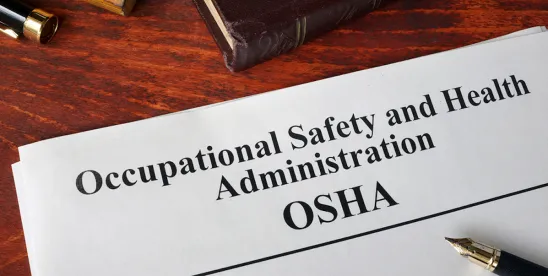The Occupational Safety and Health Administration (OSHA) has amended its Hazard Communication Standard (HCS), 29 C.F.R. § 1910.1200, to align with Revision 7 (Rev. 7) of the United Nations’ Globally Harmonized System of Classification and Labelling of Chemicals (GHS). The changes described in 89 Fed. Reg. 44,144 (May 20, 2024) revise criteria for hazard classification, provisions for labeling, and concentrations claimed as trade secrets. Compliance with the new provisions is due in stages between January 19, 2026, and January 19, 2028.
Background
OSHA first promulgated the HCS in 1983 to standardize communication of workplace hazards associated with exposure to hazardous chemicals. The HCS requires chemical manufacturers and importers at the top of the supply chain to determine hazards for their products using available information and to provide that hazard information on labels and safety data sheets (SDSs) to downstream recipients of those products.
Since the original HCS, OSHA has actively participated in efforts to develop an internationally harmonized system of chemical hazard communication. A unified classification system was touted to establish an internationally consistent standard for the safe management of hazardous chemicals and provide workers and consumers across the world with information about those chemicals. In 2012, OSHA officially harmonized its standards with the third revision of the GHS, which was first published in 2008. The GHS is updated every two years based on feedback from regulatory agencies, industry, and non-governmental organizations. The most recent update, Rev. 9, was published in July 2021.
OSHA’s adoption of Rev. 7 aligns the HCS with other domestic agencies and international trading partners, including Canada and the EU (who adopted similar rules in 2023). This update seeks to ensure that hazardous chemical warnings are accurate based on all available evidence and simplifies compliance for large corporations subject to consistent international standards.
Major Changes
- Hazard classifications must consider the “reasonably anticipated uses” of a chemical. This is a potentially significant change but less challenging than the original proposal.
- Small containers no longer require complete hazard information if the immediate outer package contains it.
- Manufacturers and importers have more flexibility to claim ingredient concentration ranges as a trade secret.
- Definitions and classifications are updated.
Hazard Classifications
New language in paragraph (d) provides that hazard classification by manufacturers and importers must consider chemical reactions during normal use conditions, reflecting OSHA’s longstanding view from its guidance that manufacturers should consider downstream hazards. The final rule requires chemical manufacturers and importers to consider a chemical’s “reasonably anticipated uses” when classifying hazards. The description of “reasonably anticipated uses” underwent considerable changes from the February 16, 2021 proposed rule to the final rule. OSHA has not clarified which specific uses are implicated by this language.
OSHA amended Appendix A (health hazard criteria) and Appendix B (physical hazard criteria) to add new hazard classes. The final rule updates the criteria for skin corrosion/irritation and serious eye damage/irritation to reflect GHS Rev. 8’s expanded use of non-animal test methods. OSHA reorganized its classification of physical hazards to create a new desensitized explosives category and a new subcategory of flammable gases. It also expanded the aerosols class to include nonflammable aerosols. These changes reflect the Rev. 7 hazard classifications.
Labels
In paragraph (f), labels and other forms of warning, OSHA created new small container labeling standards to ease the burden on stakeholders who struggle to include all hazard information on small containers. Under the final rule, stakeholders may present limited information on containers smaller than 100 ml, but only if complete information is reflected on its immediate outer package. Containers smaller than 3 ml only require a product identifier and do not require a label.
The 2012 HCS update led to stakeholder difficulties in complying with the label update requirements, particularly for chemicals traveling through long distribution cycles. To address these concerns, under the new rule, if there are significant changes to a chemical’s established hazards or ways to protect against them, containers of chemicals released for shipment and awaiting distribution do not need to be relabeled. Instead, chemical manufacturers and importers may include the updated label for each container with each shipment.
OSHA made changes to clarify the general labeling process. Under the final rule, a chemical manufacturer or importer may send a label electronically only when the recipient agrees to this arrangement. If a container has a Department of Transportation pictogram, the HCS pictogram for the same hazard is now optional. Previously, DOT and HCS pictograms for the same hazard were not allowed together. The HCS also allows for an exception to the requirement to label the immediate container of a bulk shipment if the immediate container is the mode of transportation (such as a tanker truck or rail car).
Appendix C (allocation of label elements) updated the Hazard Not Otherwise Classified “HNOC (non-mandatory)” identification with the exclamation point pictogram to codify an agreement between OSHA and Health Canada. OSHA also updated precautionary statements, guidance, and hazards in Appendix C.
Safety Data Sheets
SDSs provide more detailed safety and technical information about hazardous chemicals than labels. OSHA made two minor changes to paragraph (g) to ensure consistency and accessibility of SDSs. The 2012 HCS update states that a chemical manufacturer or importer preparing the SDS must ensure it is in English. To prevent confusion for chemical manufacturers and importers that obtain rather than prepare SDSs, the new amendment reads, “the chemical manufacturer or importer shall ensure the SDS is in English.”
The original version of the HCS allowed employers to design SDSs to cover groups of hazardous chemicals rather than address each chemical individually. Under the 2012 HCS, SDSs were standardized, requiring each SDS to address a single chemical. The new rule returns some flexibility to stakeholders by allowing SDSs to cover groups of hazardous chemicals.
OSHA updated Appendix D (safety data sheets) with several changes to the contents of SDSs to align with Rev. 7. Section 9 of the SDS, physical and chemical properties, has been revised to list the required physical and chemical properties of the chemical in the same order as in the GHS. OSHA has also revised the physical and chemical properties themselves to align with Rev. 7, such as replacing “appearance” with “physical state” and “color.” Section 11 of the SDS, toxicological information, has new paragraphs (e) for interactive effects and (g) to provide that when specific chemical information is not available, the SDS must indicate the use and source of alternative information.
Trade Secrets
The 2012 version of paragraph (i), trade secrets, allowed a chemical manufacturer to withhold the name or concentration of a hazardous substance in a mixture as a trade secret. Chemical manufacturers and importers may now claim as trade secrets not only the exact percentages of an ingredient in a mixture, but also its range of chemical concentration. If they claim a concentration or a concentration range as a trade secret, the chemical manufacturer and importer must use a prescribed range. These prescribed ranges are the same as Canada’s system, allowing the same SDS to be used in American and Canadian workplaces.
Definitions
OSHA has updated its definitions in paragraph (c) to reflect the changes made to the HCS and to align with Rev. 7. Notably, OSHA’s definition of “bulk shipment” is narrower than the Department of Transportation’s “bulk packaging” definition and does not include intermediate bulk containers. OSHA determined that the DOT definition includes intermediate forms of packaging and declined to adopt it.
Compliance Deadlines
The HCS amendments become effective on July 19, 2024. Under revised paragraph (i), chemical manufacturers, importers, and distributors must comply with the new rule’s provisions by January 19, 2026, for substances and by July 19, 2027, for mixtures. Employers must update their labeling, hazard communication programs, and employee training for substances by July 19, 2026, and January 19, 2028, for mixtures. Compliance with either the 2012 version or the 2024 version of the HCS is acceptable for periods prior to those dates.
Conclusion
Chemical manufacturers and importers should begin to review their hazard classifications, labels, and SDSs to determine the need for changes in light of the new requirements. While OSHA provided phased compliance deadlines, experience has shown that implementation may take the entire period up to the compliance deadlines. Employers using chemicals should also ensure that their workplace labeling, written hazard communication programs, and training align with the amended HCS.






 />i
/>i

